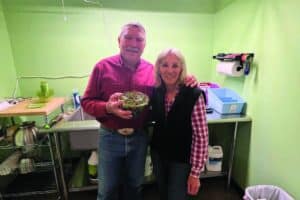In June, Colorado Gov. John Hickenlooper asked the United States Department of Agriculture to declare three counties in southern Colorado – Baca, Crowley and Otero – as primary natural disaster areas because of wheat and forage crop failures caused by a drought that officially started Jan. 1.Farmers in El Paso County and six other Colorado counties also qualify for emergency assistance because of their proximity to the primary disaster counties.It’s not just southern Colorado.The University of Nebraska at Lincoln, Neb., monitors drought conditions in the United States. The university’s drought monitoring map shows that Arizona, New Mexico, Texas, Oklahoma and the southeast part of the United States are experiencing drought conditions as well.According to the drought outlook map prepared by the National Oceanic and Atmospheric Administration, drought is expected to persist in Texas and Oklahoma through Oct. 31 and improve in southern Colorado, Arizona and New Mexico.By “improve” NOAA means at minimum a one-category improvement; for example, from exceptional to severe, that does not necessarily imply drought elimination.Mike Meyer runs the FSA’s Colorado Springs office, which covers El Paso, Elbert, Park, Teller and Douglas counties.Meyer and his staff drove the five counties evaluating the areas most affected by the drought.As of mid-July, of the five counties Meyer covers, the drought has had the greatest impact in southern El Paso County. There, bankers report that cattle producers are starting to cull the herds heavier than normal, he said.It’s a balancing act between the number of cattle and the rancher’s ability to pay to feed them when there is no grass, Meyer said. August will be a make-or-break month for many ranchers.Farmers are planting feedstock crops to replace the failed wheat crop. With some rain, those crops will come to market and ease feed prices. But if drought conditions continue, the feedstock crops will fail and prices will go up, putting more pressure on farmers and ranchers, Meyer said.Ranchers will be looking ahead to see how many cattle they can carry over the winter. If they have to start feeding early, it cuts into profit margins, which are always right on the line anyway, he said.With farmers’ failed crops and ranchers allocating more money to feed, the drought has affected local businesses and nonprofit organizations, too.The USDA’s declaration of a drought disaster in Colorado allows the U.S. Small Business Administration to offer low-interest Economic Injury Disaster Loans to qualifying small businesses and private nonprofit organizations.The SBA provides low-interest, working capital loans to small businesses having difficulty meeting their bills because of the drought, said Richard Jenkins, spokesman for the SBA in Sacramento, Calif.For businesses, the interest rate is 4 percent.An example of a business in need of the loan is a diner that relies on farmers and ranchers who can’t afford to eat out anymore because they have to buy feed for their livestock, Jenkins said.Private nonprofit organizations affected by drought could also qualify for an SBA Economic Injury Disaster Loan, with an interest rate of 3 percent.Jenkins said small business owners and operators of nonprofits can qualify for a loan by showing how the drought has impacted their operation, typically by providing a comparison of the operation’s finances before and after the drought began.Like any other loan program, they also look for a reasonably good credit history and the ability to repay the loan from the normal cash flow, he said. “We don’t do cookie-cutter loans,” Jenkins said. “Each application is based on its own merit. We do a complete and thorough financial analysis of each business or private nonprofit to determine whether they qualify.”Unlike SBA loans available through banks, such as The State Bank, U.S. Bank and J.P. Morgan Chase Bank, Economic Injury Disaster Loans are direct loans between the borrower and taxpayers, he saidWith the exception of nurseries, which are eligible for an SBA Economic Injury Disaster Loan in the case of a drought, businesses primarily engaged in farming or ranching are not eligible for SBA loans.Instead, agricultural enterprises in El Paso County interested in an emergency loan should contact Cheryl Bridge in the Pueblo, Colo., FSA office at 719-543-8386, said FSA farm loan manager, Allen Page.To apply for an SBA Economic Injury Disaster Loan, visit https://disasterloan.sba.gov/ela or call 800-659-2955 to request a printed application. The deadline to apply is Feb. 24, 2012.






